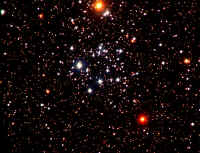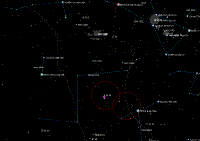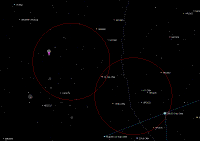M50 (open cluster in Monoceros)
570: M50 image
M50 is a beautiful open cluster in Monoceros. It may have been discovered by Cassini of Saturn fame in 1711, but Messier discovered it independently on April 5, 1772. M50 is roughly 3,000 light years distant, contains about 200 stars in the main body, and has a maximum extent of about 16 by 20 arcminutes, with the bright central portion being a circle of about 16 arcminutes, or about half the diameter of the full moon. M50 is fairly young for an open cluster, being 78 million or so years old.
580: M50 with binoculars
The Astronomical League rates M50 as an “Easy” object with 7X50 binoculars, which indeed it is from Bullington. To locate M50 in binoculars, start at Sirius in Canis Major. Swing your binocular toward Procyon in Canis Minor until Sirius is on the edge of the field. Continue on the same line about another full binocular field and you’ll spot M50 as a small bright patch centered in your field.
Finding M50 in your telescope isn’t much harder. I probably shouldn’t admit this for fear of not being allowed to run with the big dogs, but I don’t bother with the Telrad or starhopping to find M50 in the main scope. I find M50 pretty much the same way I do with binoculars. I just put the optical finder on Sirius and then swing the scope on a line toward Procyon while looking through the finder. M50 is about two full finder fields along that line, and is quite prominent in the 8X50 finder. It takes about 30 seconds to get M50 centered in the finder and visible in the eyepiece.
590: M50 by Starhopping
If you do want to starhop to M50, the easiest way is to start from Sirius in Canis Major. These circles assume a 5.5 degree field for your optical finder, which is pretty typical. Put Sirius on one edge of the finder field, with the field skewed toward Procyon. The relatively bright star on the far side of the field is 14 Theta Canis Majoris, at magnitude 4.07. Continue on that same line until 14 Theta Canis Majoris is on the far edge of the finder field, and you should be able to spot M50 as a nebulous patch about half the diameter of the full moon on the same line near the far edge of the finder field.
Most open clusters respond best to a low-power, wide-field eyepiece, but M50 is bright enough and small enough that you can use moderate powers on it. I generally don’t bother with a wide-field eyepiece for M50. Once I have it centered in the optical finder, I use our 14mm Pentax XL, which yields about 90X and a ¾ degree field in our 10” Dob.


